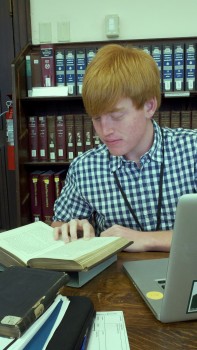A Summer at the Mütter

Details
Those who look behind the skeletons and historic medical instruments at the Mütter Museum this summer might find Alex Tonsing '13 surrounded by Civil War diaries. Supported by a John B. Hurford '60 Center for the Arts and Humanities stipend, he is spending his time there scanning and transcribing the diary of a Civil War surgeon, which will eventually be the foundation for a new book project. He is also compiling a list of everything the Mütter owns that might be of interest in a new Civil War exhibit the museum plans to create.
Founded in 1858 as part of the College of Physicians of Philadelphia, the Mütter Museum features a collection of anatomical specimens, models and medical instruments that includes more than 20,000 items. The museum also funds annual lectures and was recently featured on the Discovery Channel show Strange Medical Mysteries.
Tonsing was drawn there by a love of medical history and an appreciation for the balance the museum maintains between being educational and fun. Among the medical oddities on exhibit are a wall full of skulls from around the world, an eight-foot long colon and a 70-pound ovarian cyst. There are also many old medical instruments, which Tonsing says are“more akin to torture devices that anything else.”
“The museum is incredibly informative,” he says,“but the nature of the objects on display lend an air of creepiness.” But that creepiness only adds to the fun of working at the Mütter for Tonsing.
This is not his first experience with history research. Last summer, Tonsing assisted Professor Bethel Saler with her work on U.S.-North African relations between 1776 and 1815 (which centered on the Barbary Pirates) by building a comprehensive bibliography and hunting down newspaper articles by John Quincy Adams.
Going into the internship at the Mütter, Tonsing had very little experience with Civil War history. “To learn about the battles of Gettysburg and Antietam straight from the diaries of surgeons who were there is incredibly rewarding,” he says,“It never gets old to flip through a pamphlet or book from the 19th century and find answers directly from the source.”
Tonsing says that his biggest surprise came when he realized how much work goes into running a museum like the Mütter. Only twelve percent of the museum's collection is on display, but the entire collection has to be constantly maintained. “For example,” says Tonsing,“the wet specimen room is filled with jars containing objects like amputated feet or brain pieces floating in alcohol or formaldehyde. Many of these specimens are very old and need to be cleaned and the fluid changed.” Caring for the collection is a big job for the museum's small staff, which Tonsing describes as hard working and dedicated“It's pretty incredible what they're able to do here,” he says.
—Jack Hasler ‘15



